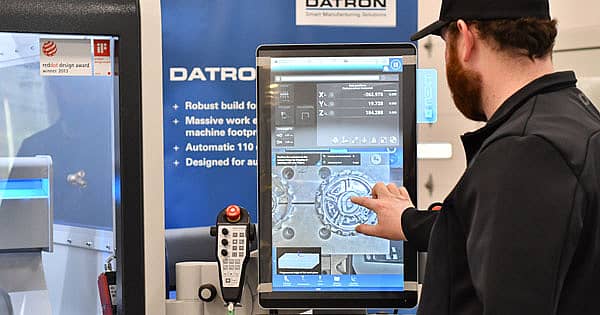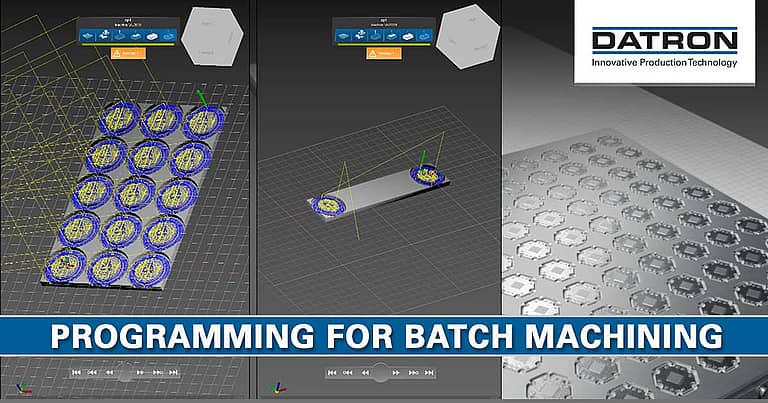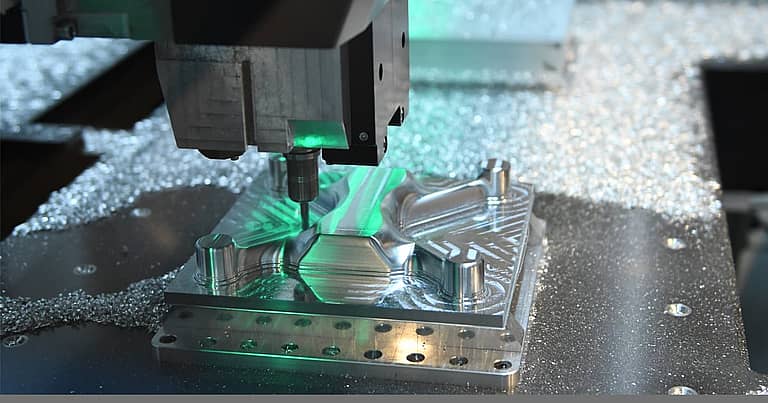
At the core of every CNC machining process lies a meticulously crafted program that dictates every movement of the machine’s cutting tools. This is where the CNC machine programmer steps in. They are the architects behind the scenes, responsible for writing, debugging, and optimizing the code that drives the CNC machines. This article explains what is a CNC programmer, as well as the responsibilities, skills, and a CNC programmer job description to help you better understand this exciting career that can be applied to many industries.
The Role of a CNC Machine Programmer
A CNC machine programmer plays a pivotal role in modern manufacturing, translating design specifications into precise instructions that guide computer numerical control (CNC) machines in the fabrication process. Merging technical expertise with creativity, they analyze blueprints, engineering drawings, and CAD models to develop efficient machining programs.
With a keen eye for detail, CNC machine programmers meticulously consider factors like tool selection, cutting paths, and machining sequences to optimize production efficiency and ensure accuracy. Beyond programming, they continuously monitor and troubleshoot machine operations, adjusting parameters to maintain quality standards. Their work requires a blend of problem-solving skills, technical proficiency, and a deep understanding of machining principles, contributing significantly to the seamless execution of manufacturing processes.
Responsibilities of a CNC Programmer
The responsibilities of a CNC programmer are multifaceted and crucial to the success of manufacturing operations. As the backbone of modern manufacturing, CNC machine programmers hold a critical role in the production process, bridging the gap between design concepts and tangible products. To understand what is a CNC programmer, you must look at the responsibilities of those holding this position.
1. Programming
Programming, the translation of specifications into precise instructions that control the movements of cutting tools and machining operations, is the responsibility of a CNC programmer. This intricate process begins with a deep understanding of the design requirements, including engineering drawings, CAD models, or other design specifications. Selecting the appropriate machining strategy, cutting tools, and machining parameters follows, considering factors such as material properties, tool capabilities, and desired machining outcomes.
The programmer uses specialized CAM software to generate toolpaths that define tool movement relative to the workpiece and specify machining parameters such as cutting speeds, feed rates, and spindle speeds. With meticulous attention to detail, they write G-code, the language understood by CNC machines, instructing the machine on executing the machining operations. Throughout the process, the CNC programmer’s expertise in machining principles, CAD/CAM software proficiency, and problem-solving skills ensure the creation of accurate and efficient machining programs.
2. Selecting Cutting Tools
The CNC programmer is responsible for selecting the cutting tools best suited for the specific machining operation and material being worked on. The programmer must thoroughly understand the operation’s requirements, including the machined material, the desired surface finish, tolerances, and other relevant factors.
When selecting cutting tools, the programmer considers machining parameters such as cutting speed, feed rate, depth of cut, and coolant requirements to ensure optimal performance and tool life. Specialized machining operations may sometimes require custom or specialized cutting tools.
3. Performing Workholding Setup
Determining workholding solutions that securely hold the workpiece during machining operations is another crucial aspect of a CNC programmer’s job description. Based on the characteristics of the workpiece and machining requirements, the programmer chooses suitable workholding devices such as vises, vacuum chucks, fixtures, clamps, or specialized workholding systems.
In some cases, especially for complex or specialized workpieces, the programmer may design custom fixtures tailored to the specific geometry and requirements of the part. This involves creating detailed drawings or CAD models of the fixtures for fabrication or procurement.
4. Calibrating Machine Parameters
Calibrating machine parameters helps to make sure that the CNC machine operates with precision and accuracy, which is another essential part of the role of CNC programmers. Before calibration, the programmer ensures the CNC machine is appropriately set up and aligned. This involves checking the machine’s mechanical components, such as the spindle, axis drives, and tooling.
The programmer uses precision measuring tools such as dial indicators, micrometers, and laser alignment devices to measure key machine parameters such as spindle runout, axis positioning accuracy, and repeatability. They verify that the machine meets the specified performance criteria. If necessary, the programmer fine-tunes machine parameters, making incremental adjustments to achieve the desired machining performance while maintaining stability and reliability.
5. Conducting Test Runs and Inspections
Conducting test runs and inspections is crucial for CNC machine programmers to verify the accuracy and quality of machining programs before full-scale production. Before running the actual machining program on the workpiece, the programmer may conduct a dry run simulation using the machine’s simulation software or built-in simulation features. This allows them to visualize the toolpaths and machining operations without cutting material. They will then allow the machine to warm up to its operating temperature for consistent performance during the test run. This involves running the spindle and axes through a series of movements to stabilize machine components and minimize thermal expansion effects.
Next, they will conduct the test run of the machining program, closely monitoring the machine’s operation for any issues or abnormalities. The CNC programmer observes tool movements, spindle speeds, feed rates, and coolant flow to ensure they are consistent with the programmed parameters. Once the test run is complete, the programmer inspects the part for dimensional accuracy, surface finish, and any defects or imperfections that may have occurred during the machining.
6. Troubleshooting Machine Operations
Troubleshooting machine operations is a key responsibility of CNC machine programmers to provide smooth and efficient production processes. To begin, the programmer continuously monitors the CNC machine’s operation during machining. When an issue arises, the programmer interprets error messages or alarms displayed on the machine’s control panel or interface.
This is where they will analyze the machining results by inspecting the quality of the machined part, checking tool wear and potential damage, and verifying the workpiece setup. CNC programmers will also adjust the machining parameters during their troubleshooting process. By systematically identifying and addressing issues in CNC machine operations, programmers can be sure that their parts are machined correctly and accurately each time.
7. Optimization
CNC programmers optimize operation efficiency through a meticulous approach that focuses on streamlining processes, reducing cycle times, and maximizing machine utilization. They begin by analyzing machining requirements and identifying opportunities for improvement, such as optimizing toolpaths, reducing tool changes, or implementing advanced machining strategies. Leveraging their expertise in CAM software, they fine-tune machining parameters such as cutting speeds, feed rates, and toolpath strategies to minimize idle time and maximize material removal rates while maintaining quality standards.
Additionally, CNC programmers may explore automation and batch-processing techniques to enhance throughput and minimize manual intervention. Continuous monitoring and analyzing machine performance allows them to identify bottlenecks or inefficiencies and implement corrective measures. By adopting a proactive approach to optimization, CNC programmers play an essential role in enhancing productivity, reducing production costs, and ensuring the smooth and efficient operation of CNC machining processes.
Skills Required for a CNC Programmer
To truly know what is a CNC programmer, you must understand the skills included in a CNC programmer’s job description. To excel in this role, you need a diverse set of skills that combines technical proficiency, problem-solving abilities, and attention to detail. Firstly, a strong understanding of machining principles, including knowledge of cutting tools, materials, and machining processes, is essential. CAD/CAM software proficiency is vital for generating accurate toolpaths and machining programs.
Additionally, a mathematical aptitude for calculating machining parameters and interpreting engineering drawings is necessary. Critical thinking and problem-solving skills enable CNC programmers to troubleshoot issues, optimize processes, and adapt to changing requirements effectively. Excellent communication skills are also important for collaborating with colleagues, engineers, and machinists to ensure clarity and accuracy in translating design specifications into machining instructions.
It’s also to be noted that adaptability and a willingness to learn are essential traits as CNC technology and industry practices evolve rapidly. Overall, a CNC programmer must possess a combination of technical expertise, analytical thinking, and interpersonal skills to succeed in this dynamic, demanding, and exciting field of work!
Future Outlook
As manufacturing processes continue to evolve with advancements in automation, artificial intelligence, and Industry 4.0 technologies, the role of CNC machine programmers will remain indispensable. The demand for skilled professionals who can harness the power of CNC machining to drive innovation and efficiency will only continue to grow.
However, DATRON CNC machines offer a range of features and capabilities that streamline the work of CNC programmers, making their jobs more efficient and effective. Our CNC milling machines are known for their user-friendly interfaces and intuitive software, which simplify the programming process and reduce the learning curve for programmers. DATRON machines often come equipped with advanced CAM software that allows programmers to generate complex toolpaths and machining programs easily.
DATRON machines are designed for high-speed machining, allowing programmers to achieve faster cycle times and increased productivity without sacrificing precision or surface finish. Our machines’ robust construction and stability ensure reliable performance, while features such as tool length measurement systems and automatic tool changers further automate and streamline machining processes. DATRON CNC machines empower CNC programmers to focus on optimizing machining processes and producing high-quality parts rather than getting bogged down by complex programming tasks.
If you are looking to enhance your production speed, quality, and capabilities, DATRON has the solutions you may not even know you need! Contact us today to improve your overall machining processes and keep up with the rapidly growing demands today!







